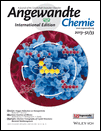Nitroxyl Radicals for Studying Electron Transfer†
Dr. Tamar Eliash
Dept. of Organic Chemistry, Weizmann Institute of Science, Rehovot 76100 (Israel)
Search for more papers by this authorCorresponding Author
Dr. Antonio Barbon
Dept. of Chemical Sciences, University of Padova, Via Marzolo 1, 35131 Padova (Italy)
Antonio Barbon, Dept. of Chemical Sciences, University of Padova, Via Marzolo 1, 35131 Padova (Italy)
Lev Weiner, Dept. of Chemical Research Support, Weizmann Institute of Science, Rehovot 76100 (Israel)
Search for more papers by this authorProf. Marina Brustolon
Dept. of Chemical Sciences, University of Padova, Via Marzolo 1, 35131 Padova (Italy)
Search for more papers by this authorProf. Mordechai Sheves
Dept. of Organic Chemistry, Weizmann Institute of Science, Rehovot 76100 (Israel)
Search for more papers by this authorDr. Itzhak Bilkis
Faculty of Agricultural, Food and Environmental Sciences, Hebrew University, Rehovot 76100 (Israel)
Search for more papers by this authorCorresponding Author
Dr. Lev Weiner
Dept. of Chemical Research Support, Weizmann Institute of Science, Rehovot 76100 (Israel)
Antonio Barbon, Dept. of Chemical Sciences, University of Padova, Via Marzolo 1, 35131 Padova (Italy)
Lev Weiner, Dept. of Chemical Research Support, Weizmann Institute of Science, Rehovot 76100 (Israel)
Search for more papers by this authorDr. Tamar Eliash
Dept. of Organic Chemistry, Weizmann Institute of Science, Rehovot 76100 (Israel)
Search for more papers by this authorCorresponding Author
Dr. Antonio Barbon
Dept. of Chemical Sciences, University of Padova, Via Marzolo 1, 35131 Padova (Italy)
Antonio Barbon, Dept. of Chemical Sciences, University of Padova, Via Marzolo 1, 35131 Padova (Italy)
Lev Weiner, Dept. of Chemical Research Support, Weizmann Institute of Science, Rehovot 76100 (Israel)
Search for more papers by this authorProf. Marina Brustolon
Dept. of Chemical Sciences, University of Padova, Via Marzolo 1, 35131 Padova (Italy)
Search for more papers by this authorProf. Mordechai Sheves
Dept. of Organic Chemistry, Weizmann Institute of Science, Rehovot 76100 (Israel)
Search for more papers by this authorDr. Itzhak Bilkis
Faculty of Agricultural, Food and Environmental Sciences, Hebrew University, Rehovot 76100 (Israel)
Search for more papers by this authorCorresponding Author
Dr. Lev Weiner
Dept. of Chemical Research Support, Weizmann Institute of Science, Rehovot 76100 (Israel)
Antonio Barbon, Dept. of Chemical Sciences, University of Padova, Via Marzolo 1, 35131 Padova (Italy)
Lev Weiner, Dept. of Chemical Research Support, Weizmann Institute of Science, Rehovot 76100 (Israel)
Search for more papers by this authorL.W. thanks Harry Gray for stimulating discussions, and all of the authors are grateful to both Harry Gray and Jeff Warren for critical reading of the manuscript and for constructive comments and suggestions. We thank Israel Silman for valuable discussions while writing our responses to the referees and for editing the manuscript.
Graphical Abstract
Electron-transfer (ET) rates are measured by use of time-resolved EPR spectroscopy, involving photooxidation of nitroxyl radicals by a ruthenium bipyridyl complex. This permits acquisition of the fundamental characteristics of ET in solution. The method was used on two spin-labeled derivatives of bacteriorhodopsin, and is applicable to proteins, nucleic acids, and biological membranes.
Supporting Information
As a service to our authors and readers, this journal provides supporting information supplied by the authors. Such materials are peer reviewed and may be re-organized for online delivery, but are not copy-edited or typeset. Technical support issues arising from supporting information (other than missing files) should be addressed to the authors.
| Filename | Description |
|---|---|
| anie_201210207_sm_miscellaneous_information.pdf291.3 KB | miscellaneous_information |
Please note: The publisher is not responsible for the content or functionality of any supporting information supplied by the authors. Any queries (other than missing content) should be directed to the corresponding author for the article.
References
- 1R. A. Marcus, N. Sutin, Biochim. Biophys. Acta Rev. Bioenerg. 1985, 811, 265–322.
- 2H. B. Gray, J. R. Winkler, Q. Rev. Biophys. 2003, 36, 341–372.
- 3C. Wei, A. J. Bard, M. V. Mirkin, J. Phys. Chem. 1995, 99, 16033–16042.
- 4W. Ford, M. Rodgers, J. Phys. Chem. B 1997, 101, 930–936.
- 5H. Gray, J. Winkler, Chem. Phys. Lett. 2009, 483, 1–9.
- 6H. S. White, W. G. Becker, A. J. Bard, J. Phys. Chem. 1984, 88, 1840–1846.
- 7M. C. Krishna, D. A. Grahame, A. Samuni, J. B. Mitchell, A. Russo, Proc. Natl. Acad. Sci. USA 1992, 89, 5537–5541.
- 8A. P. Todd, J. Cong, F. Levinthal, C. Levinthal, W. L. Hubbell, Proteins Struct. Funct. Genet. 1989, 6, 294–305.
- 9X. Fu, S. Bressler, M. Ottolenghi, T. Eliash, N. Friedman, M. Sheves, FEBS Lett. 1997, 416, 167–170.
- 10I. Ron, L. Sepunaru, S. Itzhakov, T. Belenkova, N. Friedman, I. Pecht, M. Sheves, D. Cahen, J. Am. Chem. Soc. 2010, 132, 4131–4140.
- 11R. N. Schwartz, M. Peric, S. A. Smith, B. L. Bales, J. Phys. Chem. B 1997, 101, 8735–8739.
- 12G. Saracino, A. Tedeschi, J. Phys. Chem. A 2002, 106, 10700–10706.
- 13A. L. Kaledin, Z. Huang, Y. V. Geletii, T. Lian, C. L. Hill, D. G. Musaev, J. Phys. Chem. A 2010, 114, 73–80.
- 14H. O. Finklea, N. Madhiri, J. Electroanal. Chem. 2008, 621, 129–133.
- 15R. C. Young, F. R. Keene, T. J. Meyer, J. Am. Chem. Soc. 1977, 99, 2468; H. Oberhofer, J. Blumberger, Angew. Chem. 2010, 122, 3713–3716; Angew. Chem. Int. Ed. 2010, 49, 3631–3634.
- 16T. Eliash, L. Weiner, M. Ottolenghi, M. Sheves, Biophys. J. 2001, 81, 1155–1162.
- 17F. Sepulcre, A. Cordomí, M. G. Proietti, J. J. Perez, J. García, E. Querol, E. Padrós, Proteins Struct. Funct. Bioinf. 2007, 67, 360–374.
- 18S. Manda, I. Nakanishi, K. Ohkubo, H. Yakumaru, K. Matsumoto, T. Ozawa, N. Ikota, S. Fukuzumi, K. Anzai, Org. Biomol. Chem. 2007, 5, 3951–3955.
- 19E. Eskelinen, M. Haukka, T.-J. J. Kinnunen, T. A. Pakkanen, J. Electroanal. Chem. 2003, 556, 103–108.
- 20L. Weiner, Appl. Magn. Reson. 2007, 31, 357–373.
- 21J. M. Mayer, Annu. Rev. Phys. Chem. 2004, 55, 363–390.





